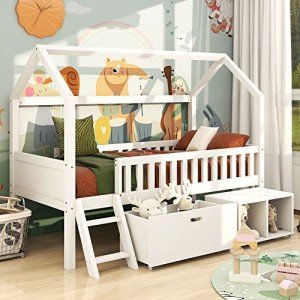The Ultimate Guide to Kids Bunk Beds: Maximizing Space and Fun
With the increase of vertical living and smaller areas, the appeal of bunk beds has skyrocketed amongst families. Bunk beds not only use a practical sleeping solution, specifically in shared rooms, but they also bring an aspect of fun into a child's life. Bunk Bed For Adults UK into the features, advantages, and considerations of kids' bunk beds, making it much easier for moms and dads to pick the right bed for their little ones.
Functions of Kids Bunk Beds
Bunk beds are versatile furniture pieces that serve more than a single purpose. Here are some key functions to consider:
| Feature | Description |
|---|---|
| Product | Bunk beds can be built from wood, metal, or a combination of both, providing varying levels of sturdiness and style choices. |
| Security Features | The majority of bunk beds come geared up with guardrails, safe ladders, and topped supports for safety, specifically important for young kids. |
| Style Variety | Choices vary from classic designs to modern-day styles, making sure a match for any room décor. |
| Space-Efficiency | Bunk beds utilize vertical space, making them perfect for smaller rooms. |
| Convertible Options | Some models can be transformed into two different beds, providing flexibility as kids grow. |
| Storage Solutions | Some bunk beds include built-in storage drawers or racks, assisting to keep the space arranged. |
Advantages of Kids Bunk Beds
Purchasing a bunk bed features numerous benefits:
- Space Saving: Bunk beds maximize flooring space, permitting more backyard or storage services.
- Enjoyable Factor: With a bunk bed, kids belong that fosters imagination and companionship throughout pajama parties or playdates.
- Cost-efficient: Instead of acquiring two different beds, a bunk bed can accommodate two children at as soon as, saving cash in the long run.
- Flexibility: Many bunk beds can be taken apart or converted into twin beds, making them a long-lasting financial investment as children's requirements change.
- Social Interaction: Bunk beds encourage household bonding and relationships, supplying a welcoming space for kids to share stories and laughter.
Factors to consider When Choosing a Kids Bunk Bed
When picking the perfect bunk bed for a kid, parents ought to consider different aspects:
- Safety Standards: Ensure that the bunk bed adhere to security policies and includes essential safety features.
- Age Appropriateness: Different designs cater to various age. For instance, conventional bunk beds may not be suitable for younger kids.
- Room Dimensions: Measure the bed room to guarantee the bunk bed fits appropriately, enabling space to walk around easily.
- Weight Capacity: Consider the weight load of each bed and ensure it accommodates the child's weight easily.
- Style Preferences: Letting children take part in the selection process can help them feel more thrilled about their brand-new bed.
Types of Kids Bunk Beds
Bunk beds are available in different styles and configurations to match different needs:
| Type | Description |
|---|---|
| Standard Bunk Bed | A traditional design with one bed stacked on top of another, normally utilizing a ladder to access the top bunk. |
| L-Shaped Bunk Bed | Functions two bunk beds linked in an L-shape, typically more roomy and appropriate for kids sharing a space however requiring a bit more space. |
| Triple Bunk Bed | Makes up 3 stacked beds, suitable for making the most of sleeping plans in very minimal areas. |
| Loft Bed | A raised bed with space underneath that can act as a backyard, research study corner, or additional storage. |
| Futon Bunk Bed | Integrates a bunk bed on the top with a futon or couch underneath, making it great for sleepovers and maximizing room use. |
| Convertible Bunk Bed | Can be separated into two specific beds, providing flexibility as children's needs change. |
Caring for Kids Bunk Beds
Keeping bunk beds is vital for making sure longevity and safety. Here are some simple care practices:
- Regular Inspections: Check the bed regularly for loose screws and tightened bolts to make sure stability.
- Tidiness: Keep bedding clean and fresh, rotating mattresses for even wear.
- Guardrails: Ensure guardrails are secure and in place, particularly if children tend to walk around a lot in their sleep.
- Air Circulation: Ensure the bed has adequate air flow, preventing moisture buildup that can cause mold or mildew.
FAQs About Kids Bunk Beds
Q1: At what age can a child securely utilize a bunk bed?
A1: Generally, kids aged 6 and older are considered safe to use the upper bunk due to the height and stability elements involved.
Q2: Can I position a bunk bed near a window?
A2: It is a good idea to avoid putting a bunk bed near windows to decrease the threat of falling or injuries.
Q3: Are bunk beds safe for younger kids?
A3: While some contemporary bunk beds include safety functions accommodating more youthful children, it is normally advised to wait until they are older, typically over 6 years.
Q4: What is the common weight limit for top bunks?
A4: Weight limits differ by design however typically vary from 150 to 250 pounds. Constantly describe the maker's specifications.
Q5: How often should I inspect the bunk bed's safety features?
A5: It is suggested to perform a security check every couple of months or whenever you discover any indications of wear.
Kids' bunk beds serve as a tactical option for families seeking to take full advantage of space while offering an enjoyable and appealing sleeping environment for their children. With a variety of options offered-- from standard designs to loft beds-- parents have the freedom to select something that fulfills their household's specific requirements. By considering vital elements such as safety, space suitability, and their kids's preferences, parents can make an informed option, ensuring that each child is thrilled about bedtime while benefiting from an efficient room.

